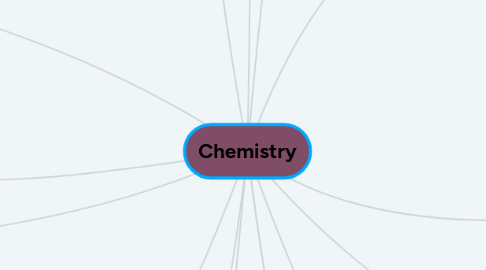
1. Periodic Table
1.1. Families
1.1.1. Halogens
1.1.2. Noble Gases
1.1.3. Alkali Metals
1.1.4. Alkaline Earth Metals
1.1.5. Metalloids (transition metals)
1.2. Metals
1.2.1. examples: Sodium, Nickel, Potassium
1.3. Non-Metals
1.3.1. ex: carbon, oxygen, phosphorus
1.4. Metalloids
1.4.1. ex: boron, silicon, arsenic
2. Compounds
2.1. Ionic
2.1.1. form when electrons are transferred between elements
2.1.2. metal and non-metal
2.1.2.1. change metal ending to "ide"
2.1.3. criss cross for formula
2.1.4. Lithium Nitride (Li3N)
2.2. Molecular
2.2.1. between non metal elements
2.2.2. no ions formed
2.2.3. covalent is another term
2.2.4. add prefixes and end of 2nd to "ide"
2.2.5. dinitrogen pentaoxide (N2O5)
3. Scientific Method
3.1. question -> think -> plan -> observe -> analyze -> conclusion -> question...
3.2. hypothesis
3.2.1. if..., then..., because...,
3.3. observations
3.3.1. qualitative
3.3.2. quantitative
3.4. inference
4. Ions
4.1. charged particles
4.2. Polyatomic
4.2.1. "blobs of non metals" stable with a charge
4.2.2. list on back of Periodic Table
5. Acids
5.1. molecular compounds named like ionic compounds
5.2. form like ions in water
5.3. increase amount of hydrogen ions (H+)
5.4. example: HCl (hydrochloric acid)
5.5. conduct electricity well
5.6. sour tasting
5.7. corrosive
5.8. reactive with many substances
6. Bases
6.1. ionic and named as so
6.2. increase amount of hydroxide (OH-)
6.3. Alkaline (another word)
6.4. bitter tasting
6.5. feel slippery
6.6. react with proteins
7. Chemical Reactions
7.1. reactants
7.1.1. before reaction
7.2. products
7.2.1. after reaction
7.3. Conservation of Mass
7.3.1. total mass of reactants = total mass of products
7.4. Classifying Reactions
7.4.1. Synthesis
7.4.1.1. A+B-> AB
7.4.1.2. putting things together
7.4.2. Decomposition
7.4.2.1. AB -> A+B
7.4.2.2. things coming apart
7.4.3. Single Displacement
7.4.3.1. one element butts in
7.4.3.2. A+BC -> AC+B
7.4.4. Double Displacement
7.4.4.1. elements swap partners
7.4.4.2. AB+CD -> AC+BD
7.4.5. Acid/Base Neutralization
7.4.5.1. elements swap partners
7.4.5.2. acid+base -> water+salt
7.4.6. Combustion
7.4.6.1. hydrocarbon + oxygen -> carbon dioxide + water
7.4.6.2. complete combustion
7.4.6.2.1. fuel + O2 -> CO2 + H2O
8. Indicators
8.1. red litmus
8.2. blue litmus
8.3. universal
8.4. PhenolP
8.5. BromoB
9. Diagrams
9.1. Bohr
9.1.1. shells
9.2. Lewis
9.2.1. only valence electrons
10. Equations
10.1. word
10.1.1. magnesium chloride + lithium -> magnesium + lithium chloride
10.2. skeleton
10.2.1. 1MgCl2 + 2Li -> 1Mg + 2LiCl
10.3. balancing
10.3.1. Br2 + AlI3 -> AlBr3 + I2
10.3.2. 3Br2 + 2AlI3 -> 2AlBr3 3I2
11. Matter
11.1. made of particles
11.2. everything with mass and volume
11.3. pure substances
11.3.1. element
11.3.2. compound
11.4. mixtures
11.4.1. solution
11.4.2. heterogenous
12. Changes
12.1. Physical
12.1.1. particles rearranged
12.1.2. changes of state
12.1.3. Examples: shattering glass, cutting paper
12.2. Chemical
12.2.1. hints
12.2.1.1. colour change
12.2.1.2. energy given off (heat or light)
12.2.1.3. gas bubbles form
12.2.1.4. solid forms in liquid
12.2.1.5. irreversible
12.2.2. new particles formed
12.2.3. examples: burning leaves, rotting garbage
13. Particles
13.1. the smallest bit of something
13.2. pure substance = same particles
13.3. have energy
13.4. always moving
13.5. Solids, liquids, gases
13.5.1. solids=no spaces
13.5.2. liquids=small spaces
13.5.3. gases=very large spaces, spread out
14. Atoms & Molecules
14.1. protons
14.1.1. positive charge
14.2. neutrons
14.2.1. neutral charge
14.3. electrons
14.3.1. negative charge
